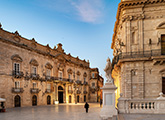Architecture in Sicily
A short history of Sicilian architecture and a guide to the traditional houses of Sicily
Since 1500 B.C., Sicily has seen a multitude of different cultures and populations, evidence of which can be seen in its architecture. Once a powerful colony of Magna Graecia, the island subsequently witnessed the various styles of its dominations from the Roman Empire to the Arabs and Normans, all leaving a range of styles from Greek and Roman to the baroque and 19th and 20th century architecture.
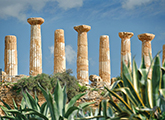
The magnificent remains of ancient architecture in Sicily testify to the important role the island held in antiquity thanks to its strategic position in the Mediterranean and to its thriving agriculture. The most important archeological site is certainly the Valley of the Temples in Agrigento, one of the most visited UNESCO sites in the world. Equally interesting are the temples of Segesta and Selinunte, as well as the numerous archeological sites dating back to Phoenician times (1600 B.C.), such as those at Mozia, and to the Greek-Roman periods in Tindari, Taormina and Syracuse. The latter, from the time of its foundation (734 B.C.), was the largest, most populous and flourishing city in Magna Graecia, well known also for its most famous citizen, the scientist Archimedes.
But Sicily also boasts a gem of rural Roman architecture: the Villa in Piazza Armerina. This splendid villa, once the property of a member of the Roman Senatorial class, preserves a mosaic of extraordinary beauty, testimony to the life of the time.
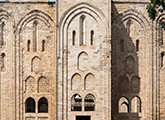
The so-called "Arab-Norman" style is the fruit of a unique historical-cultural fusion that took place in Sicily in the first centuries of the second millennium when the Normans invaded the island, at the time under Arab control. After the conquest, the Normans settled on the island but rather than destroy the traces of Arab civilization, and attracted by such a refined culture, they adapted their own styles, giving birth to one of the most extraordinary periods both for Sicily and for the Mediterranean.
These were the golden years for Palermo, that from the reign of Roger d’Altavilla (1091) to the fall of Frederick II of Swabia, known as "Stupor Mundi" (the wonder of the world), saw a flourishing of architecture with the cathedrals of Monreale and Cefalù, the church of San Giovanni degli Eremiti, buildings such as the Zisa and the Cuba, the splendid Norman palace of Orleans with the Palatina chapel and the spectacular Cathedral, where relics of the Swabian emperor Frederick II, who reigned over an empire stretching from the Rhine to Jerusalem, can be seen to this day. Lush gardens, the result of advanced technology and irrigation, palm trees and citrus groves surround the capital. Byzantine, Arab and gothic influences blend in to create a unique experimental style, the symbol of a flourishing culture that saw Palermo at the forefront of Europe, comparable only to Cordoba, Byzantium and Baghdad. This was the Sicily of knights, caliphs, Saracens and the "One Thousand and One Nights". The port of Palermo alone saw more trade than the whole of England. This period came to an abrupt end with the assassination of Corradino of Swabia in the market square of Naples (1268) and with the Angevin invasion that signaled the beginnings of Sicilian resistance known as the "Vespers" and the end of Palermo’s autonomy and influence over the Mediterranean.

This is certainly a lesser-known chapter in the history of Sicilian architecture and yet it reveals the innovative spirit with which Sicily approached the modern, industrial age. Even in the first half of the nineteenth century, a new style in Sicily was blending the different elements of the time: the neoclassical, Pompeian, baroque and late eighteenth century styles, as well as a taste for the oriental and the Anglo-Saxon. This mixture of tastes, reflecting the cultured and rather cosmopolitan court became known as "eclecticism". The most representative example is the delightful Palazzina Cinese in the Parco della Favorita in Palermo built by Ferdinand of Bourbon and his wife Maria Carolina from 1799. At the time, Sicily was home to French noblemen fleeing from France, Austrian soldiers and functionaries, English admirals and merchants and Spanish noblemen, all of whom enriched the island with buildings and works of art. Although reactionary from a political point of view, Sicily welcomed innovations in art and customs.
Perhaps the last cultural flourish took place between the nineteenth and twentieth centuries in the wake of new enthusiasm following the Unification of Italy and the defeat of the Bourbons by the Sicilian bourgeoisie. Thanks to the enterprise of families such as the Florios, the Whitakers, the Sandrons, the Ducrots, and the Basiles the towns acquired a more modern and optimistic identity. This was the era of the liberty boulevards, such as that of the Viale della Libertá in Palermo, the era of theatres and opera houses, amongst which the Teatro Massimo in Palermo, the work of Gian Battista and his son Ernesto Basile, and of villas and beach resorts such as that at Mondello, dominated by the Charleston, a perfect example of cosmopolitan Sicilian Art Nouveau.
The disappointment following a badly managed Unification, wars and the outbreak of Fascism, left Sicily in a state of poverty and lethargy from which it has still not recovered. Examples of good architecture, in the second half of the twentieth century, are few, far and in between, but these include the restoration, by the Venetian architect Carlo Scarpa, of the fifteenth century Palazzo Abatellis Museum, partially destroyed in the second World War, and the surreal Gibellina Nuova, resurrected from the rubble of the ancient village razed to the ground by the Belice earthquake in 1968. The Gibellina project involved dozens of the most famous architects and artists of the time, Francesco Venezia, Pietro Consagra, Alessandro Mendini to name but a few. This open-air contemporary art museum unfortunately comes across as an over-ambitious, visionary project, too far removed from the requirements of the area and the needs of the victims of the earthquake. Unlike the reconstruction of the Val di Noto, two and a half centuries before, this experiment has become the symbol of the failure of any modern urban vision, despite its best intentions. As if to crown this rather unusual contemporary-archeological park, Alberto Burri with an exceptional work, almost as if to symbolise the victory of modernity over the ruins of history, buried, once and for all, the ancient village of Gibellina Vecchia under concrete.
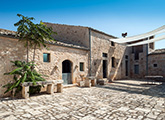
Courtyards (Bagli) and Farmhouses (Masserie)
Sicily’s fertile terrain was already being cultivated in antiquity: olives, vines and, above all, wheat to the point that the island was known as the "bread basket of Rome". At the beginning of the second millennium the Arabs, experts in water canalization introduced the cultivation of citrus fruit.
Over the centuries, so-called masserie farmhouses, varying widely in shape and size, were built near cultivations. These were used for storing and transforming agricultural produce and also often housed peasants.
On the larger estates known as latifondi, and in more isolated areas, these masserie were often fortified with few openings towards the exterior and with store houses, stalls and living quarters all overlooking an internal courtyard or baglio.
Often landowners lived in manor houses next to the masserie, during harvest time or in summer.
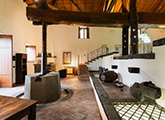
Wine Presses (Palmenti)
In vine growing areas one of the more characteristic buildings was the palmento, used for grape treading in large walled vats. Constructed on various levels, the presses still used traditional wooden mechanisms.
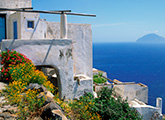
Houses on the islands
The islands surrounding Sicily with their fishing and trading ports have always attracted populations from all over the Mediterranean. Local architecture bears witness especially to Greek and North-African influence, particularly in the houses on the Aeolian islands and in the dammusi on Pantelleria:
Aeolian houses - The typically cube shaped, whitewashed houses dotted across the hills and bathed in sunlight with shady wooden pergolas upheld by concrete columns are characteristic of the seven volcanic islands that make up the archipelago. The charming interiors also boast wood beamed ceilings.
The Dammusi of Pantelleria - The traditional houses on Pantelleria, known as dammusi, with their thick walls made of local volcanic rock are perfectly adapt to the hot dry climate on the island. The roofs have a semicircular dome shape and are covered with a particular waterproof plaster. Exposed stone slabs in the exterior walls blend the house into the scenery of the island known as the Black Pearl of the Mediterranean.
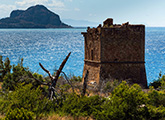
Coastal towers
Numerous proud towers look down over coasts all over the island. These evocative buildings were built between the thirteenth and nineteenth centuries though the majority date back to the period between 1450 and 1600 when, thanks to the expansion of the Ottoman Empire in the Mediterranean, Saracen pirates from North Africa infested the coasts of Southern Italy and Spain. These towers were built to spot enemy ships and send smoke signals to each other both by day and night. They were even capable of sending messages in this way around the entire island in a single day.
Positioned above bays, at river estuaries and on islets along the coast 10-30 km apart, there were three types of tower: square, cylindrical or a blunt cone shape. The interiors were constructed on a single floor closed by an arch. Their purpose was to store supplies for soldiers and for horse stables. The towers had a few narrow openings and could be climbed by either rope ladders or drawbridges. Their appearance was austere and military and the exposed walls overlooking the sea were invariably sealed.
The most beautiful of these coastal towers are those at Manfria, Torre Muzza, the tower of the Marchese di Pollina and on the Isola delle Femmine.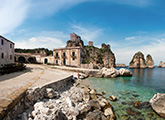
Tuna Fisheries (Tonnare)
The intimate, often conflictual relationship the Sicilians have always had with the sea is exemplified by its tuna fisheries, buildings that testify to thousands of years of Mediterranean maritime economy. Tuna fishing, one of Sicily’s most important economies right up to the industrial age, was introduced by the Arabs in the early eleventh century and is known by the rather sinister name, of Latin origin, "mattanza", recalling the cruel methods used to capture the fish. The fish were caught, under the guidance of a Rais, following traditional methods dating back a thousand years. The tuna was then brought to the fisheries, where it was broken down into its end products such as fish eggs or tuna in olive oil (introduced by the Florios in the nineteenth century).
As tuna fishing, in time, became less profitable, it lost its rather romantic connotations but at the same time left a valuable cultural heritage. The tuna fisheries are mostly found in the areas around Trapani, Palermo, Messina and Ragusa. Many have been lost to neglect but from Favignana to Capo Passero the Sicilian coast is dotted with these splendid buildings that are finally being restored with the dignity and architectural value they deserve.

